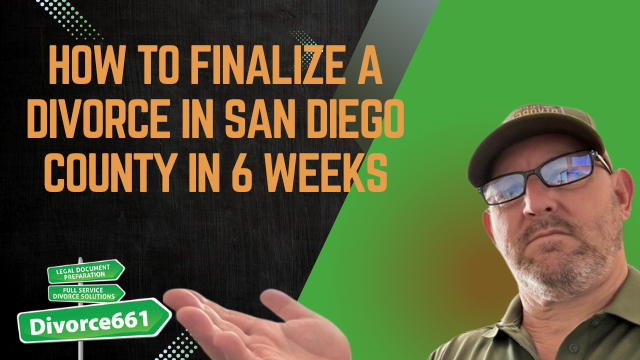How to Get a Fast Divorce in Alameda County
I’m Tim Blankenship from Divorce661. If you think you must wait six months before doing anything about your Alameda County divorce, here’s the truth: that six-month period is a waiting period for finalization — not a requirement to delay paperwork. With the right approach, you can complete everything well before that clock runs out.
Why you don’t have to wait to start
Many couples assume the six-month mark means they can’t begin the process. That’s not true. You can file the petition, exchange disclosures, settle terms, and prepare the judgment long before the waiting period ends. Filing early sets the process in motion and avoids unnecessary downtime.
“You can complete all paperwork well before the six-month period ends — the key is to act promptly.”
The 5-step path to a fast, uncontested divorce
Here’s the streamlined process we use to get divorces done quickly — often in 30 days for couples who are cooperative and provide necessary information promptly.
- File the petition.Start by filing the divorce petition with the court. Filing initiates the case and officially begins the timeline.
- Serve your spouse.Proper service ensures both parties are informed. It’s a required step and keeps the process transparent.
- Exchange financial disclosures.Complete and exchange income, assets, debts, and expense disclosures. Full disclosure reduces disputes and speeds settlement.
- Agree and sign the settlement.Once terms are agreed upon — property division, support (if any), and other provisions — sign the agreement so it can be submitted to the court.
- Submit your judgment.Prepare and submit the final judgment for the court to enter. When the documents are accurate and complete, courts often approve them without hearings.
Real client example — completed in 30 days
A friendly Alameda couple thought they had to “wait around” for six months. We filed their petition, served the papers, handled disclosures, drafted their agreement, and submitted the judgment — all in under 30 days. They still waited for the final date to pass, but by acting early they removed months of uncertainty and stress.
How we speed things up: remote work + e-filing
Modern divorce workflow eliminates many traditional delays:
- 100% remote intake and document preparation — no need for in-person meetings.
- Accurate, court-approved forms prepared by experts to avoid rejections.
- E-filing to the court to reduce processing time.
- Submissions formatted to avoid hearings when cases are uncontested and documents are complete.
Common causes of delay — and how to avoid them
Knowing the typical hold-ups helps you prevent them:
- Incomplete or inaccurate forms — double-check and use expert help.
- Missing financial disclosures — gather pay stubs, bank statements, and asset information early.
- Contested issues — keep negotiations focused and reasonable to avoid litigation.
- Incorrect or unsigned agreements — verify all signatures and dates before submission.
- Court rejections — following local rules and e-filing standards reduces back-and-forth with the court.
What to expect — timeline and tips
Typical timeline for cooperative, uncontested divorces handled remotely:
- Week 1: File petition and arrange service.
- Week 1–2: Exchange disclosures and gather documents.
- Week 2–4: Negotiate terms, finalize agreement, and sign documents.
- Week 3–4: E-file judgment and supporting documents with the court.
- After filing: Wait for the mandatory finalization period to pass (the statutory waiting period), then the judgment is entered.
Tip: Be proactive. The sooner you provide complete information, the faster the whole process moves.
Why work with Divorce661?
- Flat-fee services with no surprise bills — clear pricing.
- 100% remote handling: we manage everything from start to finish online.
- Fast, accurate, and court-ready documents prepared by experienced professionals.
- Specialized in California/Alameda County filings and local procedures.
Ready to get started?
Don’t wait to start the paperwork. By taking action now, you avoid unnecessary delays and reduce stress. If you’re in Alameda County and want a fast, smooth, remote divorce, visit Divorce661.com to schedule a free consultation. We can review your situation, explain next steps, and get your case moving right away.
Visit: Divorce661.com
Let us guide you to a quick, stress-free resolution — efficient, precise, and handled with care.










